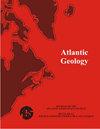加拿大新斯科舍省哈利法克斯半岛哈利法克斯群体运斜坡沉积及构造环境
IF 0.9
4区 地球科学
Q2 GEOLOGY
引用次数: 3
摘要
新斯科舍大陆南部哈利法克斯群细粒变质沉积岩可细分为可测绘单元。在哈利法克斯半岛,富硫化物的角砾岩、黑色板岩、变质泥质岩和冠纳德组的变质砂岩被灰色变质沉积岩覆盖,这些变质沉积岩具有丰富的交叉层状和局部的碳酸盐和钙硅酸盐结块,属于蓝石采石场组。没有发现蓝石采石场组的化石,但其他地方的岩性相关物是Tremadocian。在这里,蓝石采石场地层被分为四个部分。最低层(Point Pleasant段)包含薄的平行层状和交叉层状变质岩层,具有波马T型构造和T型构造,以及较厚的波马a型构造层。黑岩滩成员缺乏较厚的块状层,主要为波纹状和交叉层状的变质沉积岩。上覆的链状岩构件,一个抗侵蚀的山脊形成单元,被褶皱和束缚所破坏。层理在上部接触处被截断,内部构造被新阿卡德裂解层覆盖(因此早于此)。它们被解释为同沉积体搬运的产物。链状岩成员的稀少褶皱和下伏单元的水流波纹与北西或北西搬运方向一致。上覆的采石场成员由薄层状连贯的变质沉积岩组成,通常类似于黑岩海滩成员。虽然在哈利法克斯群其他地方的类似序列中有向上浅化的迹象,但蓝石采石场组中存在一个主要的块体搬运矿床,表明哈利法克斯群的这一部分沉积在海底古斜坡上。地质学家未能在多次考察的露头中识别出这一特征,这证明了识别被后来的构造变形叠加的同沉积变形特征的困难。本文章由计算机程序翻译,如有差异,请以英文原文为准。
Sedimentary and tectonic setting of a mass-transport slope deposit in the Halifax Group, Halifax Peninsula, Nova Scotia, Canada
Fine-grained metasedimentary rocks of the Halifax Group in southern mainland Nova Scotia can be subdivided into mappable units. In Halifax Peninsula, sulphide-rich hornfels, black slate, metasiltstone, and metasandstone of the Cunard Formation are overlain by grey metasedimentary rocks with abundant cross-laminations and local carbonate and calc-silicate concretions, assigned to the Bluestone Quarry Formation. No fossils are known from the Bluestone Quarry Formation but lithological correlatives elsewhere are Tremadocian. The Bluestone Quarry Formation is here divided into four members. The lowest (Point Pleasant member) contains thin parallel-laminated and cross-laminated metasandstone beds with Bouma T bcde and T cde structures, and thicker beds with Bouma ‘a’ divisions. The Black Rock Beach member lacks the thicker massive beds and is dominated by rippled and cross-laminated metasedimentary rocks. The overlying Chain Rock member, an erosion-resistant ridge-forming unit, is disrupted by folds and boudinage. Bedding is truncated at the upper contact, and the internal structures are overprinted by (and therefore predate) the Neoacadian cleavage. They are interpreted as products of synsedimentary mass transport. Scarce folds in the Chain Rock member and current ripples in the underlying unit are consistent with a N or NW transport direction. The overlying Quarry Pond member consists of thinly bedded coherent metasedimentary rocks that generally resemble those of the Black Rock Beach member. Although there are indications of upward shallowing in equivalent successions elsewhere in the Halifax Group, the presence of a major mass transport deposit in the Bluestone Quarry Formation shows that this part of the Halifax Group was deposited on a submarine paleoslope. The failure of geologists to identify this feature in much-visited outcrops testifies to the difficulty of identifying synsedimentary deformation features that have been overprinted by later tectonic deformation.
求助全文
通过发布文献求助,成功后即可免费获取论文全文。
去求助
来源期刊

Atlantic Geology
GEOLOGY-
CiteScore
2.10
自引率
18.80%
发文量
0
审稿时长
>12 weeks
期刊介绍:
Atlantic Geology (originally Maritime Sediments, subsequently Maritime Sediments and Atlantic Geology) covers all aspects of the geology of the North Atlantic region. It publishes papers, notes, and discussions on original research and review papers, where appropriate to the regional geology.
 求助内容:
求助内容: 应助结果提醒方式:
应助结果提醒方式:


